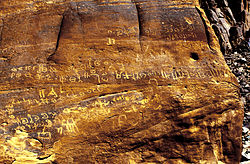- Ancient North Arabian
-
Ancient North Arabian Spoken in Arabia Extinct marginalized by Classical Arabic from the 7th century Language family Writing system South Arabian alphabet Language codes ISO 639-3 xna Ancient North Arabian is a language known from fragmentary inscriptions in modern day Iraq, Jordan, Syria and Saudi Arabia, dating to between roughly the 6th century BC and the 6th century AD, all written in scripts derived from Epigraphic South Arabian. Pre-classical Arabic (or Old Arabic), the predecessor of Classical Arabic, seems to have coexisted with these languages in central and north Arabia.[1] However, it remained spoken until it was first attested in an inscription in Qaryat Al-Faw (Qaryat Dhat Kahil) in the 1st century BC.[1][2]
Ancient North Arabian includes a number of closely related extinct dialects of pre-Islamic Arabia, summarized as Ancient or Old North Arabian (ISO 639-3 xna), including:
- Safaitic
- Dedanitic/Lihyanitic (Dedanite/Lihyanite)
- Thamudic
- Hasaitic
- Hismaic
- Taymanitic
- Dumaitic
The main characteristic differences between Classical Arabic and Ancient North Arabian:
- The definite article is h-/hn- (or zero) in Ancient North Arabian and al- in CA. However, the oldest evidence of both articles occurs in the 5th century BC, in the epithet of a goddess which Herodotus quotes in its preclassical Arabic form as ʼal-ʼilat, and which occurs in its Ancient North Arabian form as hn-ʼlt in a number of Aramaic inscriptions. Both mean "the goddess".[3]
- Verb morphology differences regarding weak roots and roots with a doubled consonant. Ancient North Arabian banaya becomes banā in CA, and bayata becomes bāta and ʼaẓlala becomes ʼaẓalla.
- In Dedanite, verb stem IV can occur in the form hafʻal(a) (perfect) and yuhafʻil(u) (imperfect). Dedanite also uses the Classical form of verb stem IV (ʼafʻala and yufʻilu).
- As in Classical Arabic, the common word order in Ancient North Arabian is VSO, but most Dedanite inscriptions show a SVO order.
- Most Ancient North Arabian languages have 28 consonantal phonemes (similar to CA). There are, however, some variations in the "s" sibilants among Ancient North Arabian languages and Classical Arabic. Taymanite has only 27 phonemes (lacks the ظ "ẓ" phoneme).
- Nasal assimilation of the vowelless "n" occurs in some Ancient North Arabian languages: ʼintaẓar "wait" becomes ʼittaẓar, and bnt "daughter" becomes bt. (The same happens in Hebrew.)
- Safaitic shows considerable alternations in roots between w and y, e.g. wrḫ which becomes yrḫ "month". (This change is also characteristic of Northwest Semitic languages).
- Safaitic and Hismaic show a -y where CA has -ā or -āʼ, such as CA samāʼ (which means heaven or sky) which occurs as smy. This y could also indicate a diphthong (ay).
- Compound (non-construct) names are more frequent in Ancient North Arabian, and occur in a manner similar to that found in Northwest Semitic names.[4] For example:
- ʼl-rym (ʼil-riyām)*: which means "high ʼil"
- ʼl-ntn (ʼil-natan)
- ntn-ʼl (natan-ʼil): which means "ʼil has given"; equivalent of Nathaniel.
- ṣlm-nʻmt
- ṣlm-ntn
- yhyṯʻ-nʻmt (yuhayṯiʻ-niʻmat)*: which means "the one who assists niʻmat". yuhayṯiʻ being the imperfect aspect of Dedanite verb stem IV (root y-ṯ-ʻ).
- ḫršt-nʻmt (ḫaršat-niʻmat)
- mt-nʻmt (this name also occurs in Phoenician inscriptions) [5]
^* ʼil and niʻmat being deity names.
Notes
- ^ a b Woodard, Roger D. Ancient Languages of Syria-Palestine and Arabia. p 180
- ^ M. C. A. Macdonald, "Reflections On The Linguistic Map Of Pre-Islamic Arabia", Arabian Archaeology And Epigraphy, 2000, Volume 11, p. 50 and 61
- ^ Woodard, Roger D. Ancient Languages of Syria-Palestine and Arabia. p 208
- ^ Alsaid, Said F. Thamudic Inscriptions from Tayma.Journal of King Saud University. Arts. Volume 17, No 1. (2005)
- ^ Alsaid, Said F. Thamudic Inscriptions from Tayma.Journal of King Saud University. Arts. Volume 17, No 1. (2005). p 202
Literature
- Lozachmeur, H., (ed.), (1995) Presence arabe dans le croissant fertile avant l'Hegire (Actes de la table ronde internationale Paris, 13 Novembre 1993) Paris: Editions Recherche sur les Civilisations. ISBN 286538 2540
- Macdonald, M.C.A., (2000) "Reflections on the linguistic map of pre-Islamic Arabia" Arabian Archaeology and Epigraphy 11(1), 28–79
- Scagliarini, F., (1999) "The Dedanitic inscriptions from Jabal 'Ikma in north-western Hejaz" Proceedings of the Seminar for Arabian Studies 29, 143-150 ISBN 2-503-50829-4
- Winnett, F.V. and Reed, W.L., (1970) Ancient Records from North Arabia (Toronto: University of Toronto)
- Woodard, Roger D. Ancient Languages of Syria-Palestine and Arabia. Cambridge University Press 2008.
Arabic · العربية Overviews 
Alphabet Letters Eras Notable varieties Standardized: Modern Standard Arabic, Regional: Egyptian · Iraqi · Levantine · Maghrebi · Sudanese · Arabian · Judeo-ArabicAcademic Calligraphy
and scriptsLinguistics Phonology · Sun and moon letters · ʾIʿrāb (inflection) · Grammar · Triliteral root · Mater lectionis · IPA · Quranic Arabic CorpusVarieties of Arabic Pre-Islamic Modern Literary Variety Maghreb Levant Mesopotamia Arabia Nile Valley Peripheral Judeo-Arabic Creoles † Extinct Categories:- Arabic languages
- History of the Arabian peninsula
Wikimedia Foundation. 2010.

